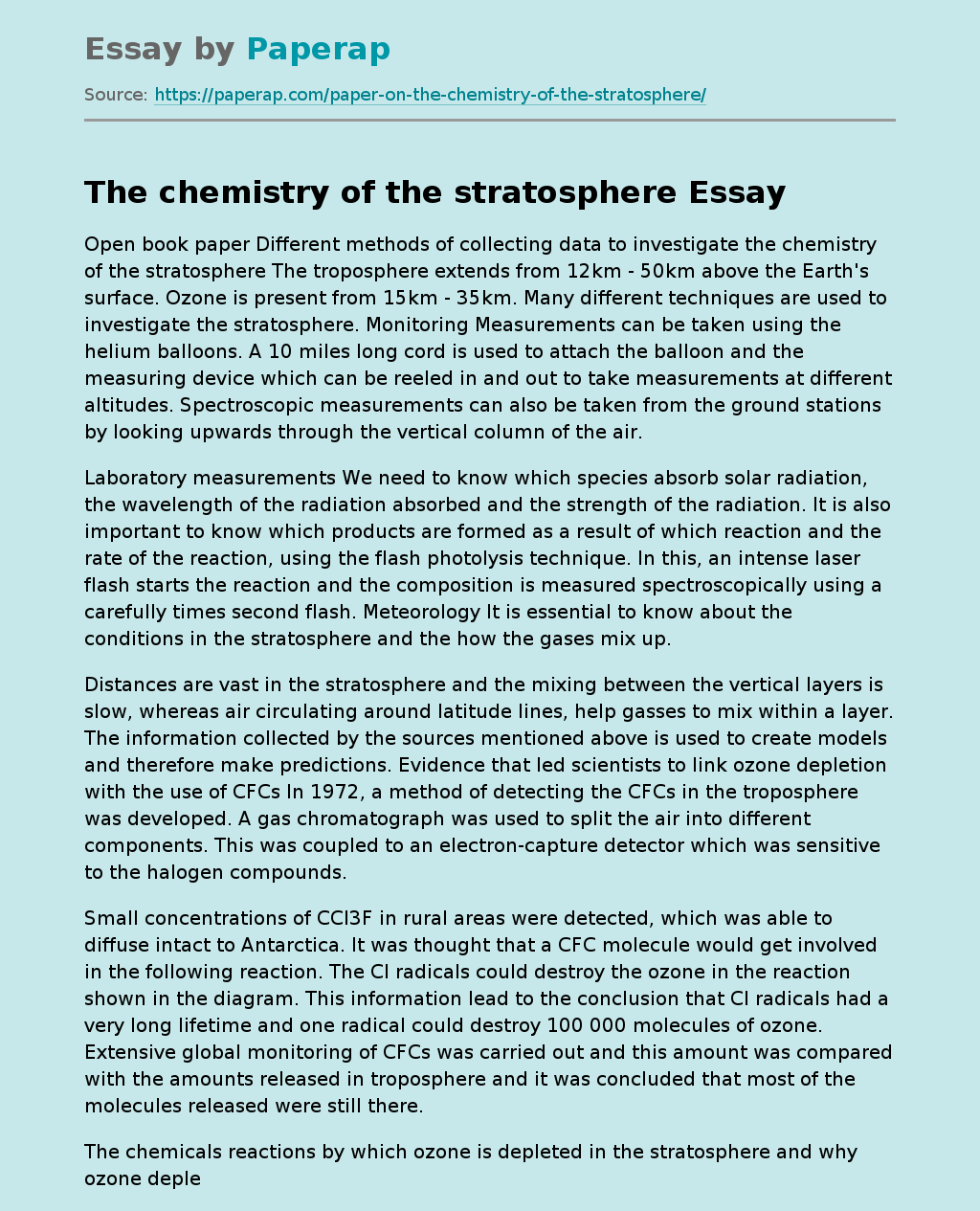Stratospheric Chemistry Data Collection Methods
The troposphere extends from 12km – 50km above the Earth’s surface. Ozone is present from 15km – 35km. Many different techniques are used to investigate the stratosphere. Monitoring Measurements can be taken using the helium balloons. A 10 miles long cord is used to attach the balloon and the measuring device which can be reeled in and out to take measurements at different altitudes. Spectroscopic measurements can also be taken from the ground stations by looking upwards through the vertical column of the air.
Laboratory measurements We need to know which species absorb solar radiation, the wavelength of the radiation absorbed and the strength of the radiation. It is also important to know which products are formed as a result of which reaction and the rate of the reaction, using the flash photolysis technique. In this, an intense laser flash starts the reaction and the composition is measured spectroscopically using a carefully times second flash. Meteorology It is essential to know about the conditions in the stratosphere and the how the gases mix up.
Distances are vast in the stratosphere and the mixing between the vertical layers is slow, whereas air circulating around latitude lines, help gasses to mix within a layer. The information collected by the sources mentioned above is used to create models and therefore make predictions. Evidence that led scientists to link ozone depletion with the use of CFCs In 1972, a method of detecting the CFCs in the troposphere was developed. A gas chromatograph was used to split the air into different components.
This was coupled to an electron-capture detector which was sensitive to the halogen compounds.
Small concentrations of CCl3F in rural areas were detected, which was able to diffuse intact to Antarctica. It was thought that a CFC molecule would get involved in the following reaction. The Cl radicals could destroy the ozone in the reaction shown in the diagram. This information lead to the conclusion that Cl radicals had a very long lifetime and one radical could destroy 100 000 molecules of ozone. Extensive global monitoring of CFCs was carried out and this amount was compared with the amounts released in troposphere and it was concluded that most of the molecules released were still there.
The chemicals reactions by which ozone is depleted in the stratosphere and why ozone depletion is most severe over Antarctica in the southern spring. Ozone depletion occurs by the release of CFCs and some other ozone-depleting substances. A single chlorine atom can break about 1million ozone molecules. When CFCs reach the stratosphere, the strong ultraviolet radiation from the sun breaks them apart, releasing chlorine which react with ozone. Cl + O3 ClO + O2 ClO formed is another radical which reacts with oxygen atoms. ClO + O2 Cl + O2
This could start the chemical cycles of ozone destruction depleting the ozone layer. Cl atoms are regenerated and can go on to react with more O3 Following is another way that the ozone could be removed. O + O3 O2 + O2 Hydroxyl radicals can also play a part in the depletion of ozone. HO + O3 HO2 + O2 The HO2 could then react with oxygen atoms. HO2 + O HO + O2 The ozone depletion is most severe over Antarctica in the southern spring which results from the weather conditions in winter because the sun disappears for a period of six months.
Air cools down making the temperature fall and clouds form in the stratosphere. These clouds contain particles of nitric acid triydrate (HNO33H2O) below 195K which are frozen around the sulphuric acid nuclei. A decrease in temperature leads to the condensation of water vapour as ice on the surface of these particles. The solid particles provide a surface for the chemical reactions to take place. Chlorine reservoirs collect on these surfaces and react. HCl + ClONO2 cloud Cl2 + HNO3 surface These chlorine atoms are released into the stratosphere.
Te return of sunlight after six months splits the chlorine molecules into chlorine atoms which leads to dramatic fall in the ozone concentration. Why the CFCs have been used so widely and the advantages and disadvantages of their replacements Chlorofluorocarbons are found to combine lox toxicity, high chemical stability and non-flammability with good performance. CFCs and the HCFCs were use as refrigerants because they have appropriate boiling point which is low enough to evaporate efficiently but high enough to liquefy by compression.
They also have a freezing point low enough to prevent the liquid from solidifying. CFCs were used for several applications, which include air conditioners, water chillers, aerosols, domestic fridges and freezers, dry cleaning and biomedical freezers. After discovering about the ozone depletion related to the use of CFCs, various other substances were to be found which would be environmentally friendly. HFCs seemed like the solution. The hydro fluorocarbons (HFCs) compounds contain only carbon, hydrogen and fluorine.
They are chosen because they contain fluorine as their only halogen. Free fluorine atoms can only be liberated from a fluorine-containing substance by putting in a considerable amount of energy. This required energy input is far more than is available in the solar radiation I the stratosphere. If the fluorine atom was to be produced, it would be highly reactive and would abstract a hydrogen atom from a molecule like water to form an inert hydrogen fluoride. No free fluorine atoms in the stratosphere would lead to no ozone destruction.
Also, HFCs are usually destroyed in the lower atmosphere by hydroxyl radicals so only a small proportion can reach the stratosphere. The disadvantage of using HFCs is that the equipment was designed to optimise the performance of CFCs and HCFCs and the use of HFCs would mean the redesigning of all the equipment. In future, cooling technologies not involving HFCs maybe introduced, especially where they have technical advantages and where the potential hazards can be easily controlled.
Stratospheric Chemistry Data Collection Methods. (2017, Dec 10). Retrieved from https://paperap.com/paper-on-the-chemistry-of-the-stratosphere/

